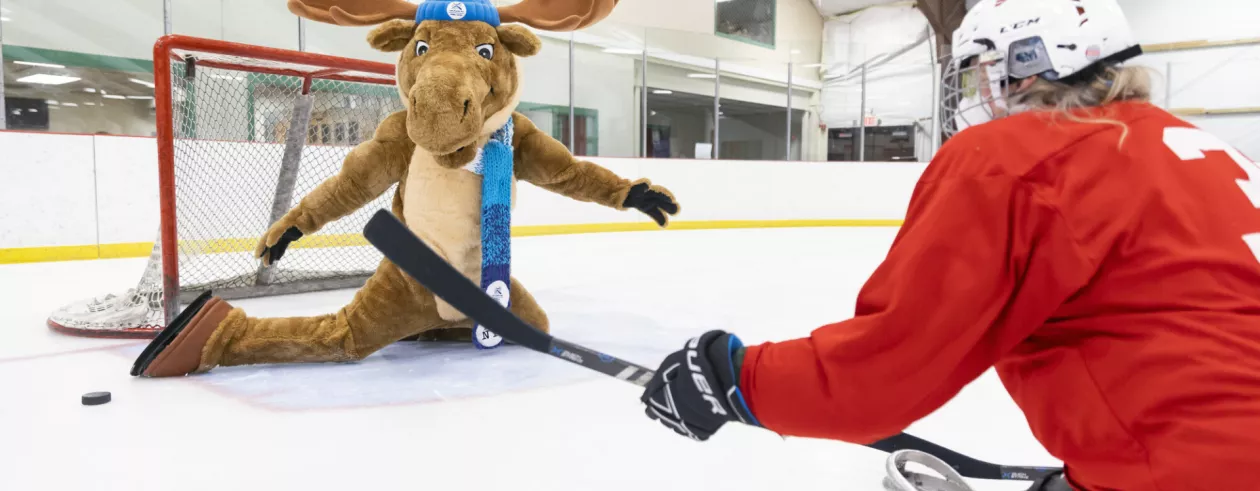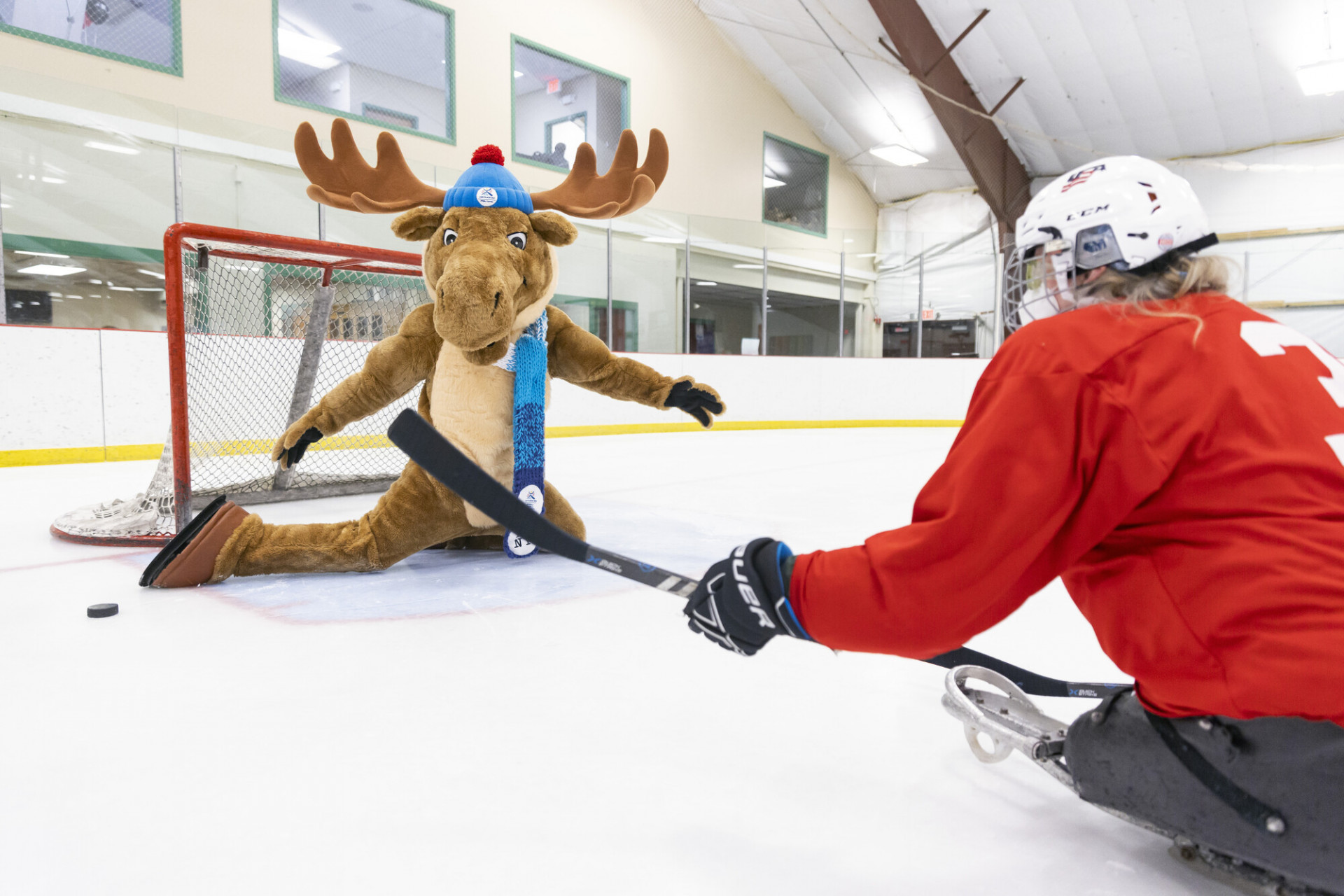
An experience to remember
Calling all sport enthusiasts! Empire State Winter Games (ESWG) are back for 2022 and there's a full schedule of exciting events.
Recently, an ESWG press conference featured a sled hockey exhibition at the Tupper Lake Memorial Civic Center. The event was given a North Country welcome with temperatures reaching as low as -7 degrees, making the ice arena a welcome place to thaw out. The event kicked off with the introduction of numerous notable speakers, including two sled hockey players who gave interviews and shared their story before hitting the ice to coach media members.
Rachel Grusse
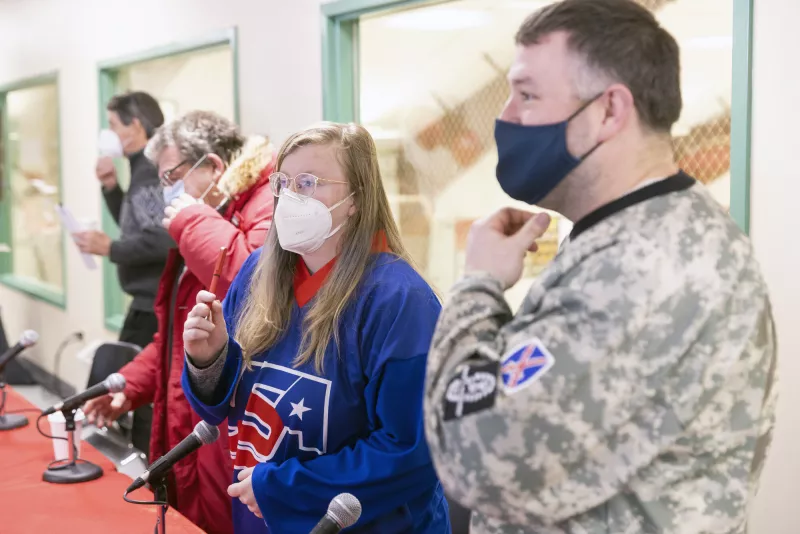
Grusse, age 29, was born without a spleen and an infection forced her legs below the knees to be amputated. She started adaptive sports at 13 years with swimming and eventually competed in the Paralympic swim trials. Grusse has competed in sled hockey for the last 10 years and has been a member of the U.S. Women’s National Development Team for 7 years. Since women’s sled hockey is not yet a Paralympic sport, Grusse often plays on men’s teams, but that doesn’t bother Grusse. She loves how physical sled hockey is and how full-on contact is a big part of the sport. She says, “I’ve had people come watch games and they’re surprised I’m checking male players, maybe two times my size.” Rachel earned a silver medal at the 2020 ESWG with the Central Vermont Pioneers.
Randy Gollinger
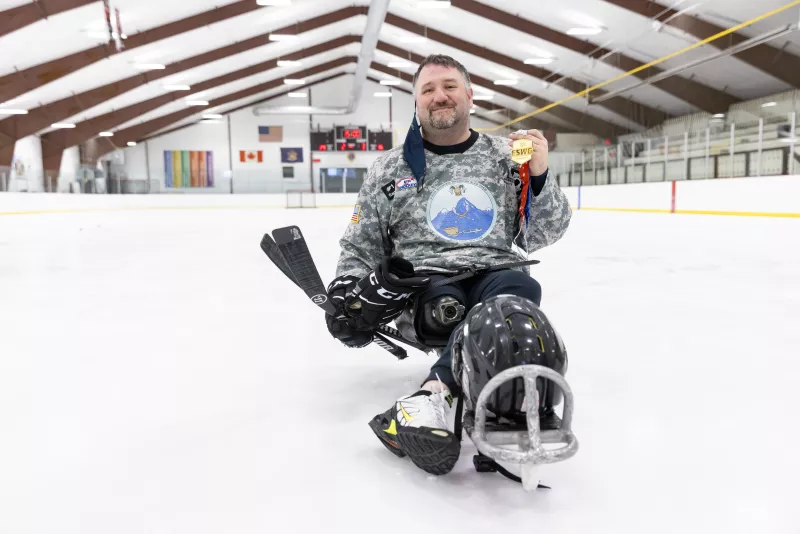
Randy, age 35, is a third-generation military man. Shortly after he turned 19, he lost an eye and a leg to a roadside bomb while serving in Iraq in 2006. It took 8 years before Randy found out about sled hockey with the help of his girlfriend. Randy said, “Every year I felt like I was dying one year at a time. The moment I first sat in a sled I felt almost at peace. This is what I was meant to do." Last year, Randy was named the ESWG Athlete of the Year and brought home a silver medal with the Fort Drum Mountain Warriors.
Sled hockey demo
As a former professional ice hockey player, I thought I would easily be able to transfer my skills to the adaptive sport, but I was in for a rude awakening. Accelerating forward using two sticks with metal picks on the butt end was the only skill I could perform intuitively. The rest was hard – turning, stopping, stick handling with two sticks, shooting, passing, etc. After 15 minutes of embarrassing trial-and-error, I decided to consult Rachel Grusse, a member of the U.S. National Women’s Sled Hockey Development Team.
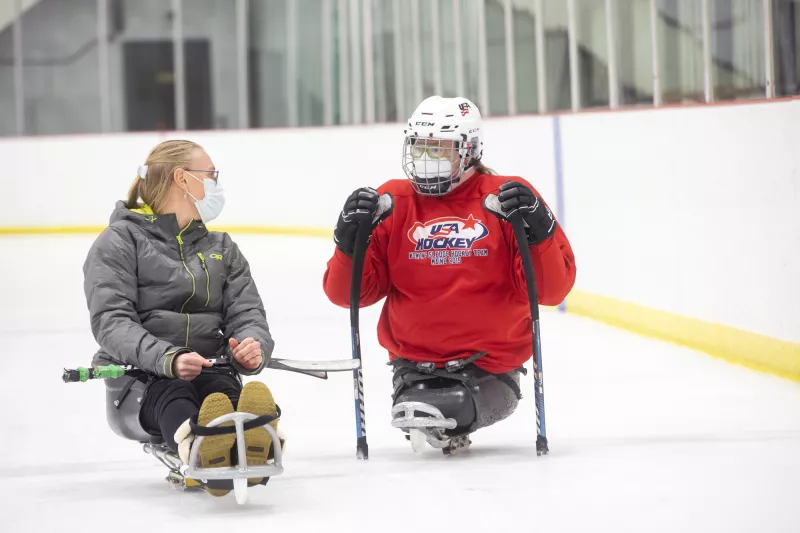
I asked Rachel for some tips on turning, so I could gain more control and feel more confident picking up speed. She explained that the two blades on my beginner sled were spaced wider apart than hers (3 inches to her 1.5 inches). This difference meant my sled was more stable, but harder to turn. Rachel also mentioned it's easier for her to turn without legs. But since I had two legs weighing me down, my center of gravity was a little different. Rachel advised me to use my core and to hold a slight edge by leaning a little. She told me to experiment with the tipping point, so I could learn how far I could lean without falling over. (Don’t ask me how many times I fell over before I figured this out!) All I can say is if someone had been filming my trials and tribulations, I would have compiled an impressive highlight reel. One move I got quite proficient at is something I call "the wheelie," which looks cool, but I'm actually one step away from wiping out. As you can see in the picture below, I'm reaching far behind me, which is disrupting my center of gravity and causing me to tip back. Occasionally, I could self-correct by leaning forward, but if I leaned too far to the left or right, down I went.
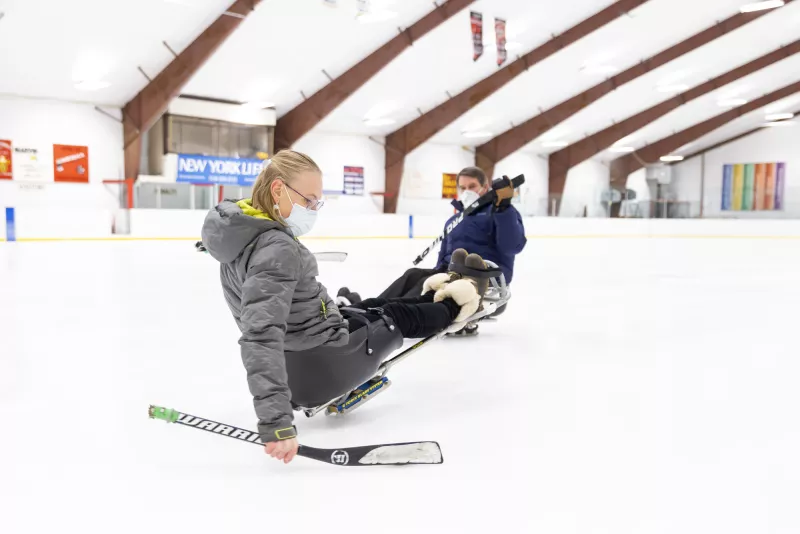
After lots of wheelies and wipeouts, I eventually I found some confidence and was ready to try some drills. Rachel and I dug our picks into the ice and started passing back and forth to each other down the ice and practiced turning at the end. After a couple of rounds of this, we added shooting to the mix, which proved to be my limit. After scoring a goal at breakneck speed, I couldn’t turn and ran right into the net. I fell over on my side with my sled tangled in the net and I couldn’t help but burst into a fit of laughter. Rachel giggled and asked, “It’s not so easy is it?” I replied, “No, Rachel, no it is not.”
Wanting to redeem myself, I asked Randy to help me with my shot. Initially, I thought shooting would be the one skill that I could pick up the fastest, but sled hockey sticks are completely different from regular ice hockey sticks. For one, in sled hockey, players use two sticks, which means you can shoot from both the left and right sides. This ambidexterity component is something that I didn’t really appreciate until I tried to lift the puck with my non-dominant hand. Another difference is sled hockey sticks are shorter, a maximum of 100 cm (3 feet), whereas regular hockey sticks typically reach between a players chin or nose. This difference in stick height means the mechanics of shooting are a little different. Randy explained that my stick should be almost completely parallel with the ice. Next, I should dip my shoulder slightly and snap right through, moving the puck from the heel of the stick to the toe. I shot around 30 pucks and I could hit the net, but I couldn’t lift the puck off of the ice. I thought to myself, “Why can’t I figure this out? I’ve been playing hockey since I was 4 years old. I should be able to do this.” But the more I thought about it, I realized how shortsighted that statement was. Sled hockey requires you to play a very physically and strategically complex sport with only the upper half of your body. As if that wasn’t hard enough, add in the ambidexterity component of passing, shooting, and stick-handling with not one, but two sticks. I am not ambidextrous, as evidenced by my total inability to pass or shoot with my non-dominant hand (left), but now I want to develop my ambidexterity skills. I can start with doing random tasks with my left hand, like eating and brushing my teeth, but even these simple tasks take a lot of effort. But everything is hard before it is easy and playing sled hockey is no different.
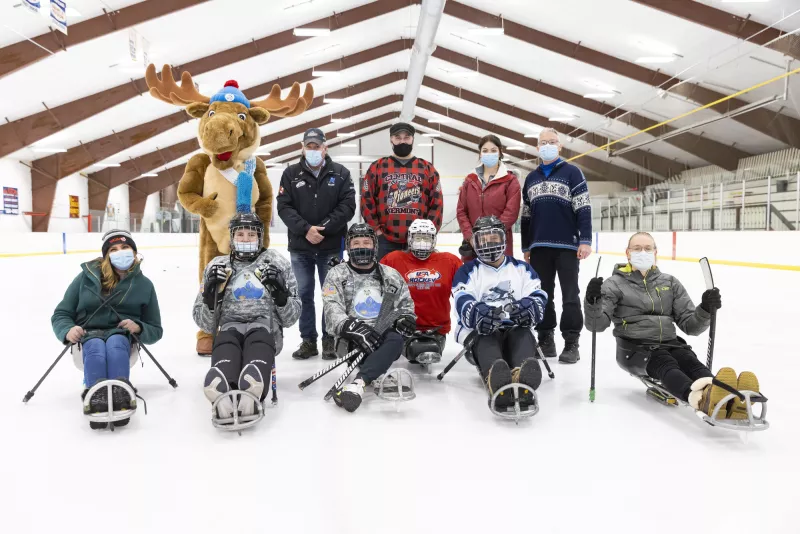
How challenging is sled hockey?
After playing on the ice for an hour, I think learning sled hockey is substantially harder than regular ice hockey. Players have to propel themselves using only their upper bodies and have to display a higher degree of ambidexterity compared to most sports. Can you think of any sports that require the same level of proficiency with both the left and right hands? The only sport I can think of is boxing, which proves my point about how rare of an occurrence ambidexterity really is in sports. What many people might not realize is sled hockey is an almost identical game to regular hockey, with the exception of one penalty, which is called T-boning. This is when one player hits another player with the front of their sled making a “T” shape. But other than that, the only really difference is in equipment. Now that I have played sled hockey first-hand, I have gained so much respect for both sled hockey and the athletes that compete in this challenging sport. I am grateful I had the opportunity to try sled hockey and the change in perspective the demo granted me. I personally want to thank ESWG for showcasing these amazing athletes and for highlighting adaptive sports.
A total of 8 sled hockey teams will be competing at the 2022 Empire State Winter Games, the largest turnout in ESWG history. Sled hockey is one of several adaptive sports on the ESWG calendar, including sled hockey, snowboard cross, skicross, alpine skiing, biathlon, and bobsled. The Empire State Winter Games is a community-driven event. Sport venues for various events are located in Lake Placid, Wilmington, Saranac Lake, Tupper Lake, Malone, and Paul Smiths. Venues include: Lake Placid Olympic Center Herb Brooks Arena, Lake Placid Olympic Jumping and Sliding complexes, Mid's Park in Lake Placid, Whiteface Mountain, Paul Smith's College, Paul Smith's College VIC, Saranac Lake Civic Center Ice Rink, Dewey Mountain Recreation Area, Tupper Lake Memorial Civic Center, Olympic Cross Country and Biathlon Center, Titus Mountain, and Mount Pisgah.
"Like" Empire State Winter Games on Facebook and follow along on Twitter and Instagram. Share your own winter sport photos by using #ESWGames!
Come join the action and cheer on these amazing athletes from February 3 - 6, 2022. It might just change your perspective.
